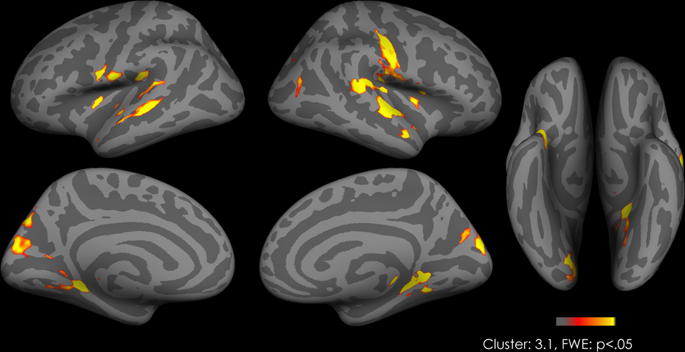当前位置:
X-MOL 学术
›
Int. J. Obesity
›
论文详情
Our official English website, www.x-mol.net, welcomes your
feedback! (Note: you will need to create a separate account there.)
Oxytocin reduces the functional connectivity between brain regions involved in eating behavior in men with overweight and obesity.
International Journal of Obesity ( IF 4.2 ) Pub Date : 2019-11-18 , DOI: 10.1038/s41366-019-0489-7 Liya Kerem 1, 2 , Nouchine Hadjikhani 3, 4 , Laura Holsen 5 , Elizabeth A Lawson 1 , Franziska Plessow 1
International Journal of Obesity ( IF 4.2 ) Pub Date : 2019-11-18 , DOI: 10.1038/s41366-019-0489-7 Liya Kerem 1, 2 , Nouchine Hadjikhani 3, 4 , Laura Holsen 5 , Elizabeth A Lawson 1 , Franziska Plessow 1
Affiliation

|
BACKGROUND
Oxytocin (OXT), shown to decrease food intake in animal models and men, is a promising novel treatment for obesity. We have shown that in men with overweight and obesity, intranasal (IN) OXT reduced the functional magnetic resonance imaging (fMRI) blood oxygenation level-dependent signal in the ventral tegmental area (VTA), the origin of the mesolimbic dopaminergic reward system, in response to high-calorie food vs. nonfood images. Here, we employed functional connectivity fMRI analysis, which measures the synchrony in activation between neural systems in a context-dependent manner. We hypothesized that OXT would attenuate the functional connectivity of the VTA with key food motivation brain areas only when participants viewed high-calorie food stimuli.
METHODS
This randomized, double-blind, and placebo-controlled crossover study of 24 IU IN OXT included ten men with overweight or obesity (mean ± SEM BMI: 28.9 ± 0.8 kg/m2). Following drug administration, subjects completed an fMRI food motivation paradigm including images of high and low-calorie foods, nonfood objects, and fixation stimuli. A psychophysiological interaction analysis was performed with the VTA as seed region.
RESULTS
Following OXT administration, compared with placebo, participants exhibited significantly attenuated functional connectivity between the VTA and the insula, oral somatosensory cortex, amygdala, hippocampus, operculum, and middle temporal gyrus in response to viewing high-calorie foods (Z ≥ 3.1, cluster-corrected, p < 0.05). There was no difference in functional connectivity between VTA and these brain areas when comparing OXT and placebo for low-calorie food, nonfood, and fixation images.
CONCLUSION
In men with overweight and obesity, OXT attenuates the functional connectivity between the VTA and food motivation brain regions in response to high-calorie visual food images. These findings could partially explain the observed anorexigenic effect of OXT, providing insight into the mechanism through which OXT ameliorates food cue-induced reward anticipation in patients with obesity. Additional studies are ongoing to further delineate the anorexigenic effect of OXT in obesity.
中文翻译:

催产素降低了超重和肥胖男性饮食行为所涉及的大脑区域之间的功能连接。
背景 催产素 (OXT) 在动物模型和男性中显示可减少食物摄入,是一种很有前途的肥胖症新疗法。我们已经证明,在超重和肥胖的男性中,鼻内 (IN) OXT 减少了腹侧被盖区 (VTA) 中的功能性磁共振成像 (fMRI) 血氧水平依赖性信号,VTA 是中脑边缘多巴胺能奖赏系统的起源。对高热量食物与非食物图像的反应。在这里,我们采用了功能连接 fMRI 分析,它以上下文相关的方式测量神经系统之间激活的同步性。我们假设只有当参与者看到高热量食物刺激时,OXT 才会减弱 VTA 与关键食物动机大脑区域的功能连接。方法 该随机、双盲、24 IU IN OXT 的安慰剂对照交叉研究包括 10 名超重或肥胖男性(平均 ± SEM BMI:28.9 ± 0.8 kg/m2)。给药后,受试者完成了 fMRI 食物动机范式,包括高热量和低热量食物、非食物物体和固定刺激的图像。以 VTA 作为种子区域进行心理生理相互作用分析。结果 服用 OXT 后,与安慰剂相比,参与者在观看高热量食物(Z ≥ 3.1,簇- 校正,p < 0.05)。当比较低热量食物、非食物和固定图像的 OXT 和安慰剂时,VTA 和这些大脑区域之间的功能连接没有差异。结论 在超重和肥胖的男性中,OXT 减弱了 VTA 和食物动机大脑区域之间的功能连接,以响应高热量的视觉食物图像。这些发现可以部分解释观察到的 OXT 的食欲减退作用,提供对 OXT 改善肥胖患者食物提示诱导的奖励预期的机制的深入了解。正在进行其他研究以进一步描述 OXT 对肥胖症的厌食作用。OXT 减弱了 VTA 和食物动机大脑区域之间的功能连接,以响应高热量的视觉食物图像。这些发现可以部分解释观察到的 OXT 的食欲减退作用,提供对 OXT 改善肥胖患者食物提示诱导的奖励预期的机制的深入了解。正在进行其他研究以进一步描述 OXT 对肥胖症的厌食作用。OXT 减弱了 VTA 和食物动机大脑区域之间的功能连接,以响应高热量的视觉食物图像。这些发现可以部分解释观察到的 OXT 的食欲减退作用,提供对 OXT 改善肥胖患者食物提示诱导的奖励预期的机制的深入了解。正在进行其他研究以进一步描述 OXT 对肥胖症的厌食作用。
更新日期:2019-11-18
中文翻译:

催产素降低了超重和肥胖男性饮食行为所涉及的大脑区域之间的功能连接。
背景 催产素 (OXT) 在动物模型和男性中显示可减少食物摄入,是一种很有前途的肥胖症新疗法。我们已经证明,在超重和肥胖的男性中,鼻内 (IN) OXT 减少了腹侧被盖区 (VTA) 中的功能性磁共振成像 (fMRI) 血氧水平依赖性信号,VTA 是中脑边缘多巴胺能奖赏系统的起源。对高热量食物与非食物图像的反应。在这里,我们采用了功能连接 fMRI 分析,它以上下文相关的方式测量神经系统之间激活的同步性。我们假设只有当参与者看到高热量食物刺激时,OXT 才会减弱 VTA 与关键食物动机大脑区域的功能连接。方法 该随机、双盲、24 IU IN OXT 的安慰剂对照交叉研究包括 10 名超重或肥胖男性(平均 ± SEM BMI:28.9 ± 0.8 kg/m2)。给药后,受试者完成了 fMRI 食物动机范式,包括高热量和低热量食物、非食物物体和固定刺激的图像。以 VTA 作为种子区域进行心理生理相互作用分析。结果 服用 OXT 后,与安慰剂相比,参与者在观看高热量食物(Z ≥ 3.1,簇- 校正,p < 0.05)。当比较低热量食物、非食物和固定图像的 OXT 和安慰剂时,VTA 和这些大脑区域之间的功能连接没有差异。结论 在超重和肥胖的男性中,OXT 减弱了 VTA 和食物动机大脑区域之间的功能连接,以响应高热量的视觉食物图像。这些发现可以部分解释观察到的 OXT 的食欲减退作用,提供对 OXT 改善肥胖患者食物提示诱导的奖励预期的机制的深入了解。正在进行其他研究以进一步描述 OXT 对肥胖症的厌食作用。OXT 减弱了 VTA 和食物动机大脑区域之间的功能连接,以响应高热量的视觉食物图像。这些发现可以部分解释观察到的 OXT 的食欲减退作用,提供对 OXT 改善肥胖患者食物提示诱导的奖励预期的机制的深入了解。正在进行其他研究以进一步描述 OXT 对肥胖症的厌食作用。OXT 减弱了 VTA 和食物动机大脑区域之间的功能连接,以响应高热量的视觉食物图像。这些发现可以部分解释观察到的 OXT 的食欲减退作用,提供对 OXT 改善肥胖患者食物提示诱导的奖励预期的机制的深入了解。正在进行其他研究以进一步描述 OXT 对肥胖症的厌食作用。









































 京公网安备 11010802027423号
京公网安备 11010802027423号